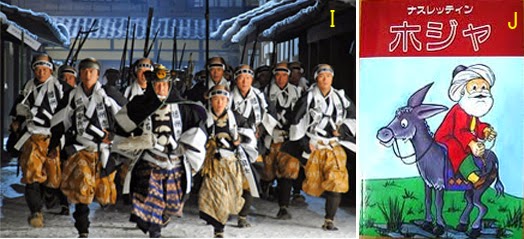デマ・偏見・盲点 16: 風刺が目指したもの 2
< 1. Comic drama >
< 1. 狂言 >
I look at Asian
satire culture and negative aspect of satire this time.
今回は、アジアの風刺文化と風刺のマイナス面を見ます。
Asian satire
The satire of classic
public entertainment (comic drama, comic monologue, etc.) poked fun at the stupidity of person, and admonished.
Occasionally, samurai and Buddhist monk were satirized with
caricature.
However, the culture to bitingly satirize
the power like Europe and America did not grow up in Japan.
アジアの風刺
日本の古典大衆芸能(狂言、落語など)の風刺は、多くが人の愚かさを揶揄し諭している。
風刺画では、侍や僧侶が風刺されることもあった。
しかし日本では欧米のように権力を辛辣に風刺する文化は育たなかったようです。
< 2. Asian satire >
< 2. アジアの風刺 >
E : Picture scroll “Choju-Jinbutsu-giga” in about the 12th century.
This caricature described by frolicking
animals and humans satirizes the society.
The scene shows a rabbit carries the
appropriate gift to a bishop of monkey who had finished a Buddhist memorial
service.
F : A caricature "Intractable disease
treatment" of the end of the Edo era in the middle the 19th century.
The scene shows some samurais who
suffered from intractable disease are visiting a skilled physician.
These diseases are “all
talk and no action”,” unprincipled” and “cowardice”, etc.
It says samurai is flaccid.
G : Comic monologue.
It is an entertainment of common people
from the Edo era, and also popular even now.
The laugh is mainly to satirize common
people’s stupid act.
H : A masque of Hahoe Folk Village in Korea.
The
scene satirizes Buddhist monk that is courting woman.
And it also satirizes Yangban (noble)
living in same village.
E: 絵巻物「鳥獣人物戯画」。12世紀頃。
動物を擬人化して社会を風刺。
この絵は法要を終えた猿の僧正に兎が御礼の品を運んでいるシーン。
F: 幕末の風刺画「難病療治」。19世紀中頃。
難病奇病を患った侍が名医を訪れているシーン。
この病は「口ばかりの病」「うちまたこうやく」「うしろをみせる病」などで、侍を軟弱と皮肉っている。
G: 落語。
江戸時代より庶民の娯楽として定着し、今も人気がある演芸。
庶民の愚かな行為を風刺する笑いが主。
H: 韓国の安東河回村の祭りで行われる仮面劇。
これは女性を口説く僧侶を風刺しているシーン。
村で共存している両班(貴族)をも風刺する。
< 3. impromptu comedy play of Hakata >
< 3.博多にわか、ブログ「ヨレヨレライダーのどたばた日記」より >
Negative aspect of satire
It is
to laugh at and to look down others.
Frequently, the satire was
preoccupied with poking fun at others and enjoying, and sometimes was used for
social sanctions and discrimination.
Aristotle
assumed the origin of Greek comedy had been to poke fun at nomadic tribe who
were driven from the town.
In the
Middle Ages of Japan, Satirical sanction was carried out in villages.
For
example, when there was a theft, village people identified someone with the
criminal.
Then, the
village people putted a large rock on front of his house at midnight, and did
not remove it until he confessed.
In
other village, people satirized a delinquency of the
villager with impromptu comedy play.
The
satirical sanction had functioned as social sanction, but became outdated when
legal system and human rights awareness advanced.
Main
problem is satire used to despise and discriminate subordinate person and an
outlander (immigration).
風刺のマイナス面
それは他者を愚弄し、貶めることです。
往々にして、風刺は他人を揶揄し愉しむだけに終始し、時には社会的制裁や差別にも使われた。
アリストテレスはギリシャ喜劇の起源を、町を追われた流浪の民を揶揄したのが始まりとしている。
中世の日本の村では風刺的制裁が行われていた。
例えば、盗難があり、犯人の目星がつくと、夜中に村人が大石をその家の前に置き、当人が白状するまで取り除かない。
また村人の非行を村人がにわか狂言(滑稽な即興の寸劇)で風刺することも行われた。
風刺的制裁は村八分(社会的制裁)として機能していたが、法制度や人権意識が進むと廃れた。
主な問題は劣位の人やよそ者(移民)を蔑視し差別することに使われる風刺です。
To
satirize different culture
Satire
will be common in identical cultural sphere, but in different cultural sphere,
there is a possibility that a harmful influence beyond each other’s understandings
arises.
I look at
two examples about differences in culture, and consider what become problems.
異文化を風刺すること
風刺は同一文化圏では共有可能でしょうが、異文化では理解を越える弊害が生じる可能性があります。
文化の違いを二例ほど見て、何が問題となるかを見ます。
< 4. Honor and laughter >
< 4. 名誉と笑い >
I : A scene of charging in drama
"Chushingura"
This is a
Japanese true story of the early 18th century, and if many Japanese see this
drama, they still shed tears.
It shows a
samurai’s honor that they took revenge for their lord and suicided by
disembowelment.
J : Folktale ”Khoja”
It
is a funny story that a Turkish saint is central
character in.
I: ドラマ「忠臣蔵」の討ち入りシーン。
18世紀初めの日本の実話で、多くの国民は今でもこれを見ると涙する。
これは主君の仇を討ち、後に全員切腹する武士の名誉を描いている。
J: 民話「ホジャ」。
トルコの聖者が主人公の笑い話、頓知話。
Honor and laughter
These are in
common in the world, but the reaction greatly varies according to the culture.
In my trip
of Turkey, I heard the funny story ”Khoja”, but it was not laughable.
The local
guide said Japanese never laugh, but I asked to speak forcibly.
After
all the difference of culture was big.
On
the next time, I look at honor.
名誉と笑い
これは世界共通なのですが、文化によって反応が大きく異なります。
トルコ旅行中、笑い話「ホジャ」を聞いたが、笑えなかった。
現地ガイドは、日本人は笑わないと言ったが、無理にお願いした。
やはり文化の違いは大きかった。
次回は、名誉について見ます。




No comments:
Post a Comment
どうぞご意見をお書き下さい。Please write an opinion.